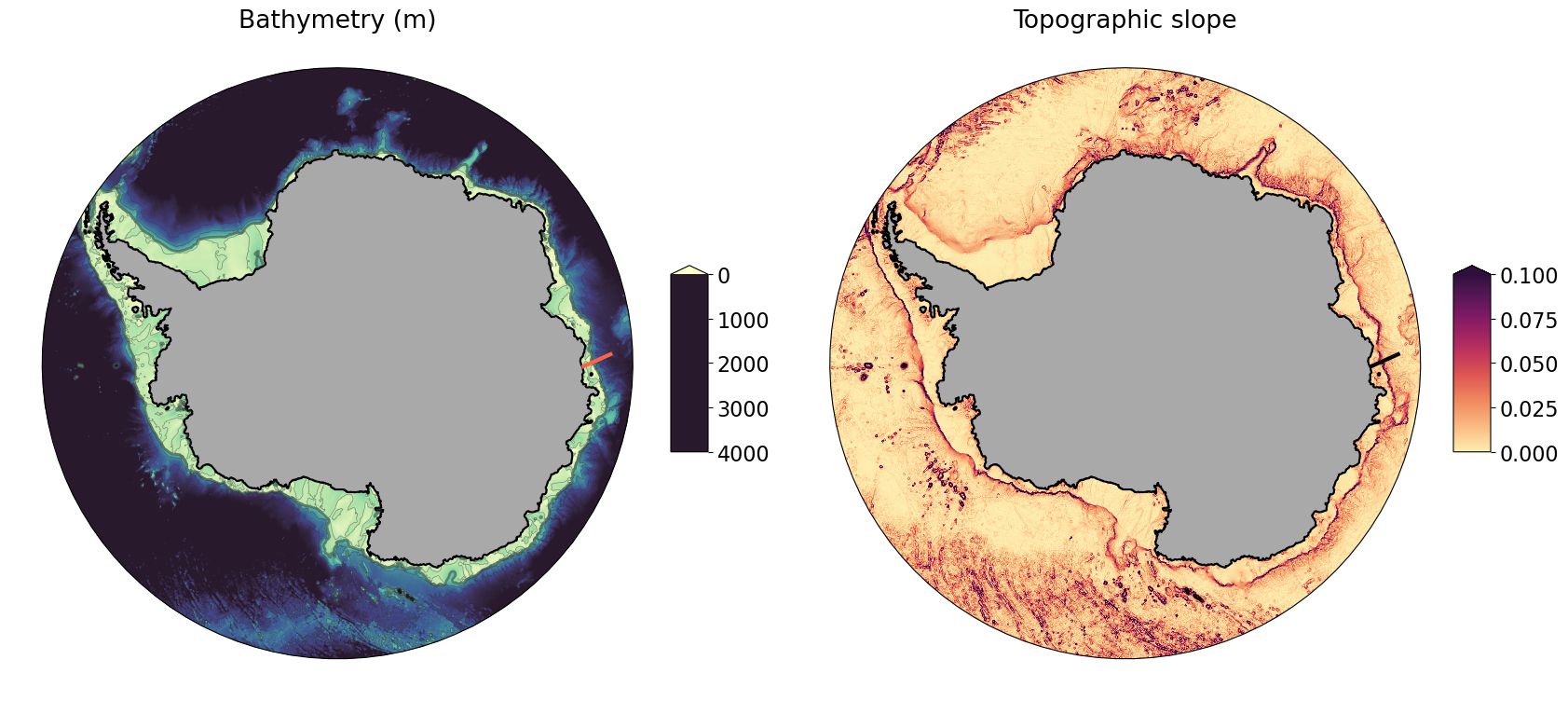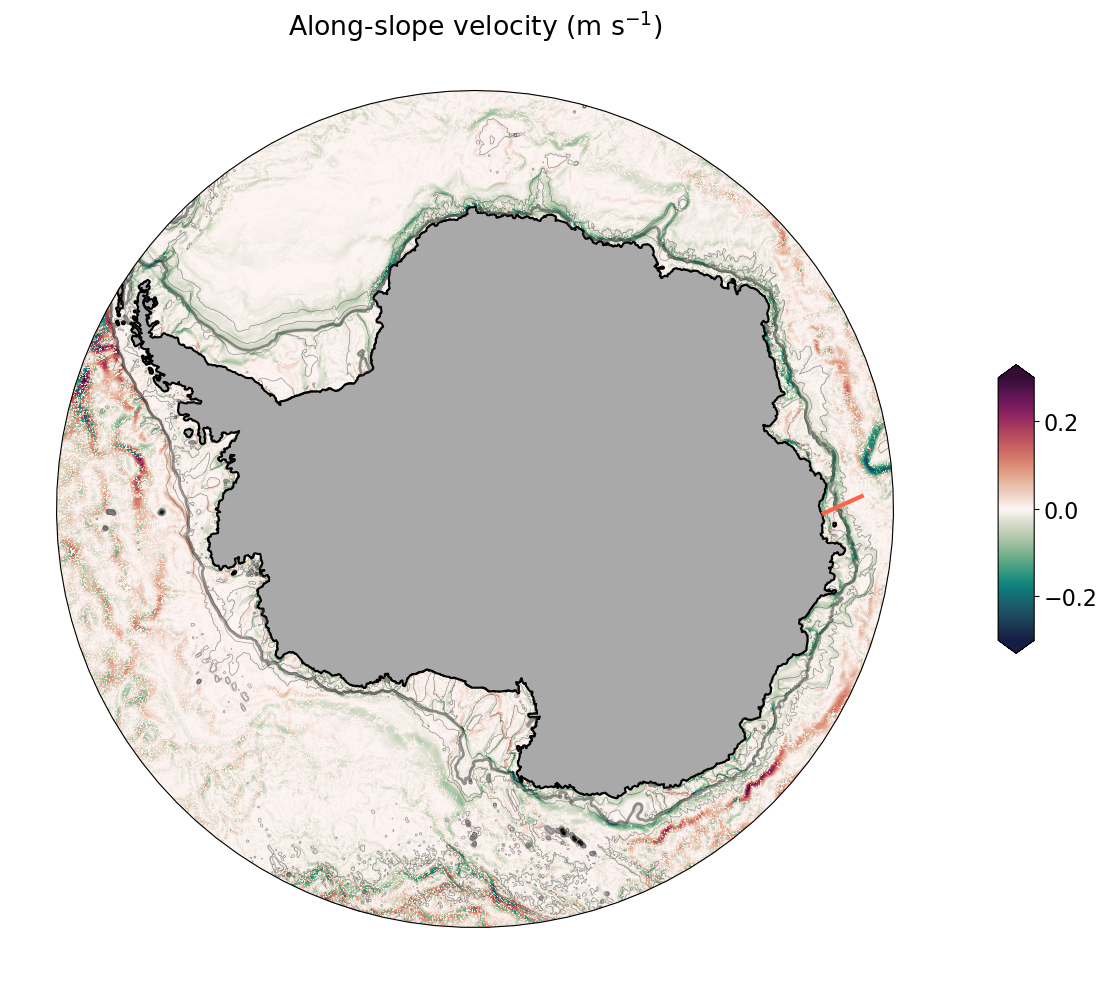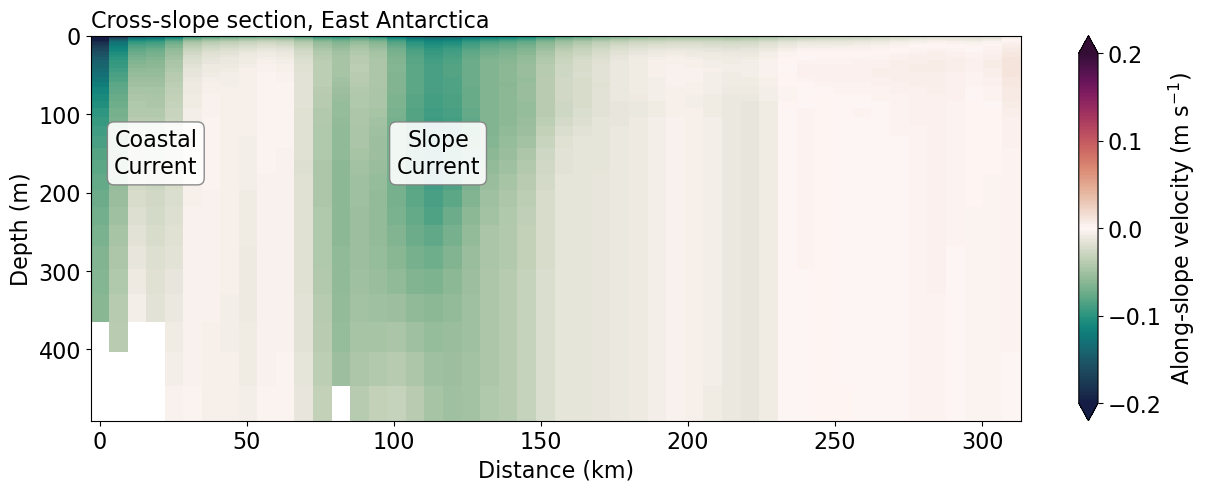Cross-slope section¶
This notebook gives an example on how to obtain a section through gridded data. We use the function metpy.interpolate.cross_section to do so. In this example we plot the along-slope velocity component across the Antarctic continental shelf break. In order to calculate the along-slope velocity component, we will need to calculate the topographic gradient first, which we do with the help
of the xgcm module.
Load modules
[1]:
# Standard modules
from pathlib import Path
import cosima_cookbook as cc
from dask.distributed import Client
import numpy as np
import xarray as xr
import xgcm
import cf_xarray
# Load metpy module to obtain cross section
# (Select the conda/analysis3-unstable kernel if you have problems loading this module)
from metpy.interpolate import cross_section
# For plotting
import cartopy.crs as ccrs
import matplotlib.pyplot as plt
import matplotlib.path as mpath
import cmocean as cm
import pyproj
By default retain metadata after operations. This can retain out of date metadata, so some caution is required
[2]:
xr.set_options(keep_attrs=True);
Start a cluster with multiple cores
[3]:
client = Client()
client
[3]:
Client
Client-676a004c-9e2c-11ed-b3a3-00000761fe80
| Connection method: Cluster object | Cluster type: distributed.LocalCluster |
| Dashboard: /proxy/36953/status |
Cluster Info
LocalCluster
ee51ab6c
| Dashboard: /proxy/36953/status | Workers: 7 |
| Total threads: 28 | Total memory: 112.00 GiB |
| Status: running | Using processes: True |
Scheduler Info
Scheduler
Scheduler-d6c6c5f7-f609-4864-91a0-df1d1ec87c12
| Comm: tcp://127.0.0.1:45507 | Workers: 7 |
| Dashboard: /proxy/36953/status | Total threads: 28 |
| Started: Just now | Total memory: 112.00 GiB |
Workers
Worker: 0
| Comm: tcp://127.0.0.1:35279 | Total threads: 4 |
| Dashboard: /proxy/43365/status | Memory: 16.00 GiB |
| Nanny: tcp://127.0.0.1:41253 | |
| Local directory: /jobfs/70947526.gadi-pbs/dask-worker-space/worker-khlidp94 | |
Worker: 1
| Comm: tcp://127.0.0.1:45199 | Total threads: 4 |
| Dashboard: /proxy/43861/status | Memory: 16.00 GiB |
| Nanny: tcp://127.0.0.1:36613 | |
| Local directory: /jobfs/70947526.gadi-pbs/dask-worker-space/worker-jirpvng4 | |
Worker: 2
| Comm: tcp://127.0.0.1:37077 | Total threads: 4 |
| Dashboard: /proxy/40091/status | Memory: 16.00 GiB |
| Nanny: tcp://127.0.0.1:38355 | |
| Local directory: /jobfs/70947526.gadi-pbs/dask-worker-space/worker-e_yucbye | |
Worker: 3
| Comm: tcp://127.0.0.1:36527 | Total threads: 4 |
| Dashboard: /proxy/44261/status | Memory: 16.00 GiB |
| Nanny: tcp://127.0.0.1:40107 | |
| Local directory: /jobfs/70947526.gadi-pbs/dask-worker-space/worker-r1pepibc | |
Worker: 4
| Comm: tcp://127.0.0.1:42807 | Total threads: 4 |
| Dashboard: /proxy/46205/status | Memory: 16.00 GiB |
| Nanny: tcp://127.0.0.1:42137 | |
| Local directory: /jobfs/70947526.gadi-pbs/dask-worker-space/worker-oy669m20 | |
Worker: 5
| Comm: tcp://127.0.0.1:46767 | Total threads: 4 |
| Dashboard: /proxy/43385/status | Memory: 16.00 GiB |
| Nanny: tcp://127.0.0.1:38465 | |
| Local directory: /jobfs/70947526.gadi-pbs/dask-worker-space/worker-0l6oxnr3 | |
Worker: 6
| Comm: tcp://127.0.0.1:33877 | Total threads: 4 |
| Dashboard: /proxy/43111/status | Memory: 16.00 GiB |
| Nanny: tcp://127.0.0.1:39855 | |
| Local directory: /jobfs/70947526.gadi-pbs/dask-worker-space/worker-yleyjv6p | |
[4]:
def centre_longitude(ds, centre=0, lonvar=None):
"""Wrap longitude to specified centre"""
if lonvar is None:
# Use cf_xarray to find longitude coordinate
lonvar = ds.cf.coordinates['longitude'][0]
upper_limit = centre + 180.
# Ensure coordinates are within range 0 -> 360
ds.coords[lonvar] = ds.coords[lonvar] % 360.
# Wrap all longitude locations above upper limit and re-sort by longitude
ds.coords[lonvar] = xr.where(ds.coords[lonvar] > upper_limit,
ds.coords[lonvar] - 360.,
ds.coords[lonvar])
ds = ds.sortby(ds[lonvar])
return ds
Load Data¶
Nominate a database from which to load the data and define an experiment
[5]:
session = cc.database.create_session()
experiment = '01deg_jra55v13_ryf9091'
Limit to Southern Ocean and single RYF year
[6]:
lat_slice = slice(-80, -59)
start_time = '2086-01-01'
end_time = '2086-12-31'
Load bathymetry data. Discard the geolon and geolat coordinates: these are 2D curvilinear coordinates that are only required when working above 65N
[7]:
hu = cc.querying.getvar(experiment, 'hu', session, n=1).drop(['geolat_c', 'geolon_c']).sel(yu_ocean=lat_slice).load()
Load velocity data, limit to upper 500m and take the mean in time
[8]:
u = cc.querying.getvar(experiment, 'u', session, ncfile="ocean.nc",
start_time=start_time, end_time=end_time).sel(yu_ocean=lat_slice).sel(st_ocean=slice(0, 500)).mean('time')
v = cc.querying.getvar(experiment, 'v', session, ncfile="ocean.nc",
start_time=start_time, end_time=end_time).sel(yu_ocean=lat_slice).sel(st_ocean=slice(0, 500)).mean('time')
Load model grid information directly from a grid data file
[9]:
path_to_folder = Path('/g/data/ik11/outputs/access-om2-01/01deg_jra55v13_ryf9091/output000/ocean/')
grid = xr.open_mfdataset(path_to_folder / 'ocean_grid.nc', combine='by_coords').drop(['geolon_t', 'geolat_t', 'geolon_c', 'geolat_c'])
Along-slope velocity¶
We calculate the along-slope velocity component by projecting the velocity field to the tangent vector, \(u_{along} = \boldsymbol{u \cdot \hat{t}}\), and the cross-slope component by projecting to the normal vector, \(v_{cross} = \boldsymbol{u \cdot \hat{n}}\). The schematic below defines the unit normal normal and tangent vectors for a given bathymetric contour, \(\boldsymbol{n}\) and \(\boldsymbol{t}\) respectively.

Accordingly, the code below calculates the along-slope velocity component as
and similarly the cross-slope velocity component as
We need the derivatives of the bathymetry which we compute using the xgcm functionality.
[10]:
# Give information on the grid: location of u (momentum) and t (tracer) points on B-grid
ds = xr.merge([hu, grid])
ds.coords['xt_ocean'].attrs.update(axis='X')
ds.coords['xu_ocean'].attrs.update(axis='X', c_grid_axis_shift=0.5)
ds.coords['yt_ocean'].attrs.update(axis='Y')
ds.coords['yu_ocean'].attrs.update(axis='Y', c_grid_axis_shift=0.5)
grid = xgcm.Grid(ds, periodic=['X'])
# Take topographic gradient (simple gradient over one grid cell) and move back to u-grid
dhu_dx = grid.interp( grid.diff(ds.hu, 'X') / grid.interp(ds.dxu, 'X'), 'X')
# In meridional direction, we need to specify what happens at the boundary
dhu_dy = grid.interp( grid.diff(ds.hu, 'Y', boundary='extend') / grid.interp(ds.dyt, 'X'), 'Y', boundary='extend')
# Select latitude slice
dhu_dx = dhu_dx.sel(yu_ocean=lat_slice)
dhu_dy = dhu_dy.sel(yu_ocean=lat_slice)
# Magnitude of the topographic slope (to normalise the topographic gradient)
topographic_slope_magnitude = np.sqrt(dhu_dx**2 + dhu_dy**2)
Calculate along-slope velocity component
[11]:
# Along-slope velocity
u_along = u * dhu_dy / topographic_slope_magnitude - v * dhu_dx / topographic_slope_magnitude
# Load the data
u_along = u_along.load()
# Similarly, we can calculate the cross-slope velocity:
#v_cross = u*dhu_dx/topographic_slope_magnitude + v*dhu_dy/topographic_slope_magnitude
/g/data/hh5/public/apps/miniconda3/envs/analysis3-22.10/lib/python3.9/site-packages/dask/core.py:119: RuntimeWarning: invalid value encountered in divide
return func(*(_execute_task(a, cache) for a in args))
/g/data/hh5/public/apps/miniconda3/envs/analysis3-22.10/lib/python3.9/site-packages/dask/core.py:119: RuntimeWarning: invalid value encountered in divide
return func(*(_execute_task(a, cache) for a in args))
/g/data/hh5/public/apps/miniconda3/envs/analysis3-22.10/lib/python3.9/site-packages/dask/core.py:119: RuntimeWarning: invalid value encountered in divide
return func(*(_execute_task(a, cache) for a in args))
/g/data/hh5/public/apps/miniconda3/envs/analysis3-22.10/lib/python3.9/site-packages/dask/core.py:119: RuntimeWarning: invalid value encountered in divide
return func(*(_execute_task(a, cache) for a in args))
/g/data/hh5/public/apps/miniconda3/envs/analysis3-22.10/lib/python3.9/site-packages/dask/core.py:119: RuntimeWarning: invalid value encountered in divide
return func(*(_execute_task(a, cache) for a in args))
/g/data/hh5/public/apps/miniconda3/envs/analysis3-22.10/lib/python3.9/site-packages/dask/core.py:119: RuntimeWarning: invalid value encountered in divide
return func(*(_execute_task(a, cache) for a in args))
/g/data/hh5/public/apps/miniconda3/envs/analysis3-22.10/lib/python3.9/site-packages/dask/core.py:119: RuntimeWarning: invalid value encountered in divide
return func(*(_execute_task(a, cache) for a in args))
Vertical averaging (we only need this to plot the velocity on a map)
[12]:
# Import edges of st_ocean and add lat/lon dimensions:
st_edges_ocean = cc.querying.getvar(experiment, 'st_edges_ocean', session, start_time=start_time, end_time=end_time, n=1)
st_edges_array = st_edges_ocean.expand_dims({'yu_ocean': u.yu_ocean, 'xu_ocean': u.xu_ocean}, axis=[1, 2])
[13]:
# Adjust edges at bottom for partial thickness:
st_edges_with_partial = st_edges_array.where(st_edges_array<hu, other=hu)
thickness = st_edges_with_partial.diff(dim='st_edges_ocean')
# Change coordinate of thickness to st_ocean (needed for multipling with other variables):
st_ocean = cc.querying.getvar(experiment, 'st_ocean', session, n=1)
thickness['st_edges_ocean'] = st_ocean.values
thickness = thickness.rename(({'st_edges_ocean': 'st_ocean'}))
thickness = thickness.sel(st_ocean=slice(0, 500))
# Depth average gives us the barotropic velocity
u_barotropic = (u_along * thickness).sum('st_ocean') / thickness.sum('st_ocean')
#v_barotropic = (v_cross * thickness).sum('st_ocean') / thickness.sum('st_ocean')
Interpolate gridded data to section¶
This is where we make use of the cross-section function from the MetPy package. It is designed for xarray, but requires the data to look in a certain way, hence we need to change the coordinate names and parse the data.
[14]:
# Create dataset
ds = xr.Dataset({"u_along": u, "lat": u.yu_ocean, "lon": u.xu_ocean, "hu": hu})
# Rename coordinate names
ds = ds.rename({'xu_ocean': 'x', 'yu_ocean': 'y'})
# Centre on zero longitude as this is what metpy requires
ds = centre_longitude(ds)
# MetPy parsing
u_parsed = ds.metpy.parse_cf('u_along', coordinates={'y': 'y', 'x': 'x'})
[15]:
# Define number of points you want to interpolate
step_no = 50
# Start and end point coordinates of section (in approximate cross-slope orientation)
shelf_coord = (-66.5, -269.3)
deep_coord = (-64, -271.9)
# Finally, interpolate gridded data onto the section
u_section = cross_section(u_parsed, start=(shelf_coord[0], shelf_coord[1]), end=(deep_coord[0], deep_coord[1]), steps=step_no, interp_type='linear')
u_section
[15]:
<xarray.DataArray 'u_along' (st_ocean: 39, index: 50)>
dask.array<dask_aware_interpnd, shape=(39, 50), dtype=float32, chunksize=(7, 50), chunktype=numpy.ndarray>
Coordinates:
* st_ocean (st_ocean) float64 0.5413 1.681 2.94 4.332 ... 383.0 423.7 468.4
metpy_crs object Projection: latitude_longitude
x (index) float64 90.7 90.64 90.58 90.53 ... 88.25 88.2 88.15 88.1
y (index) float64 -66.5 -66.45 -66.4 -66.35 ... -64.1 -64.05 -64.0
* index (index) int64 0 1 2 3 4 5 6 7 8 9 ... 41 42 43 44 45 46 47 48 49
Attributes: (12/13)
long_name: i-current
units: m/sec
valid_range: [-10. 10.]
cell_methods: time: mean
time_avg_info: average_T1,average_T2,average_DT
coordinates: geolon_c geolat_c
... ...
ncfiles: ['/g/data/ik11/outputs/access-om2-01/01deg_jra55v13_ryf90...
contact: Andy Hogg
email: andy.hogg@anu.edu.au
created: 2020-06-11
description: 0.1 degree ACCESS-OM2 global model configuration under th...
notes: Additional daily outputs saved from 1 Jan 1950 to 31 Dec ...Use pyproj to project transect coordinates into a cartesian south polar projection (see this blog post for more information)
[16]:
source_crs = pyproj.CRS(init="epsg:4326") # Global lat-lon coordinate system
target_crs = pyproj.CRS(init="epsg:3031") # Cartesian south polar projection
latlon_to_polar = pyproj.Transformer.from_crs(source_crs, target_crs)
x_m, y_m = latlon_to_polar.transform(u_section.x, u_section.y)
Calculate the euclidian distance between each point, add a leading zero for the origin and convert from metres to kilometres
[17]:
dist = np.sqrt((x_m[1:] - x_m[:-1])**2 + (y_m[1:] - y_m[:-1])**2)
dist = [0, *np.cumsum(dist) / 1000.]
Add along-transect distance coordinate in km
[18]:
u_section = u_section.assign_coords(distance=('index', dist))
Plotting¶
Create a circular path to clip plots
[19]:
theta = np.linspace(0, 2*np.pi, 100)
center, radius = [0.5, 0.5], 0.45
verts = np.vstack([np.sin(theta), np.cos(theta)]).T
circle = mpath.Path(verts * radius + center)
Create a land mask for plotting, set land cells to 1 and rest to NaN
[21]:
land = xr.where(np.isnan(hu.rename('land')), 1, np.nan)
Set default fontsize
[22]:
ft_size = 16
plt.rcParams.update({'font.size': ft_size})
Map of topographic slope and location of cross-slope section¶
[23]:
fig = plt.figure(1, figsize=(20, 10))
# create suplot axes
# the `facecolor` kwarg is used to denotes the color that should be used to fill when no data
# is available (in this case, for anything south of 80S)
ax0 = plt.subplot(1, 2, 1, projection=ccrs.SouthPolarStereo(), facecolor="darkgrey")
ax1 = plt.subplot(1, 2, 2, projection=ccrs.SouthPolarStereo(), facecolor="darkgrey")
# Set background the same for both plots
for ax in [ax0, ax1]:
ax.set_boundary(circle, transform=ax.transAxes)
# Land
land.plot.contourf(ax=ax, colors='darkgrey', zorder=2,
transform=ccrs.PlateCarree(), add_colorbar=False)
# Coastline
land.fillna(0).plot.contour(ax=ax, colors='k', levels=[0, 1],
transform=ccrs.PlateCarree(), add_colorbar=False)
# LEFT PANEL: bathymetry
# Depth contours
hu.plot.contour(ax=ax0, levels=[500, 1000, 2000, 3000],
colors='0.2', linewidths=[0.5, 2, 0.5, 0.5], alpha=0.5,
transform=ccrs.PlateCarree())
# Bathymetry
sc = hu.plot(ax=ax0, add_colorbar=False, cmap=cm.cm.deep,
transform=ccrs.PlateCarree(), vmin=0, vmax=4000)
# Customise colorbar
cbar_ax = fig.add_axes([0.48, 0.4, 0.02, 0.2])
cbar = plt.colorbar(sc, cax=cbar_ax, orientation='vertical', shrink=0.5, extend='min')
cbar.ax.invert_yaxis()
# Hack work-around for bug in matplotlib when inverting the axis, the bottom extend triangle has the under-value color
cbar.ax._children[2].set_color(cm.cm.deep.get_over())
# Location of cross-slope section (East Antarctica)
ax0.plot([shelf_coord[1], deep_coord[1]], [shelf_coord[0], deep_coord[0]],
color='tomato', linewidth=3, transform=ccrs.PlateCarree())
# RIGHT PANEL: topographic slope
# Topographic slope
sc = topographic_slope_magnitude.plot(ax=ax1, cmap=cm.cm.matter, transform=ccrs.PlateCarree(),
vmin=0, vmax=0.1, add_colorbar=False)
# Customise colorbar
cbar_ax = fig.add_axes([0.9, 0.4, 0.02, 0.2])
cbar = plt.colorbar(sc, cax=cbar_ax, orientation='vertical', shrink=0.5, extend='max')
# Location of cross-slope section (East Antarctica)
ax1.plot([shelf_coord[1], deep_coord[1]], [shelf_coord[0], deep_coord[0]],
color='k', linewidth=3, transform=ccrs.PlateCarree())
# Add titles to the subplots
ax0.set_title('Bathymetry (m)')
ax1.set_title('Topographic slope');

Map of along-slope velocity with bathymetry contours¶
[24]:
fig = plt.figure(1, figsize=(15, 15))
ax = plt.subplot(1, 1, 1, projection=ccrs.SouthPolarStereo(), facecolor="darkgrey")
ax.set_boundary(circle, transform=ax.transAxes)
# Filled land
land.plot.contourf(ax=ax, colors='darkgrey', zorder=2,
transform=ccrs.PlateCarree(), add_colorbar=False)
# Coastline
land.fillna(0).plot.contour(ax=ax, colors='k', levels=[0, 1],
transform=ccrs.PlateCarree(), add_colorbar=False)
# Depth contours
hu.plot.contour(ax=ax, levels=[500, 1000, 2000, 3000],
colors='0.2', linewidths=[0.5, 2, 0.5, 0.5], alpha=0.5,
transform=ccrs.PlateCarree())
# Along slope barotropic velocity
sc = u_barotropic.plot(ax = ax, cmap=cm.cm.curl,
transform=ccrs.PlateCarree(), vmin=-0.3, vmax=0.3,
cbar_kwargs={'orientation': 'vertical',
'shrink': 0.25,
'extend': 'both',
'label': None,
'aspect': 8})
# Location of cross-slope section (East Antarctica)
ax.plot([shelf_coord[1], deep_coord[1]], [shelf_coord[0], deep_coord[0]],
color='tomato', linewidth=3, transform=ccrs.PlateCarree())
ax.set_title('Along-slope velocity (m s$^{-1}$)');

Cross-slope section of along-slope velocity¶
[25]:
u_section.plot.pcolormesh(x='distance', y='st_ocean',
cmap=cm.cm.curl, vmin=-0.2, vmax=0.2,
cbar_kwargs={'extend':'both',
'label':'Along-slope velocity (m s$^{-1}$)'},
yincrease=False, add_labels=False, figsize=(15, 5))
plt.title('Cross-slope section, East Antarctica', fontsize=ft_size, loc='left')
plt.xlabel('Distance (km)')
plt.ylabel('Depth (m)')
# Add annotations
bbox_props = dict(boxstyle="round", fc="w", ec="0.5", alpha=0.9)
plt.text(115, 150, "Slope\nCurrent", ha="center", va="center", bbox=bbox_props)
plt.text(19, 150, "Coastal\nCurrent", ha="center", va="center", bbox=bbox_props);
